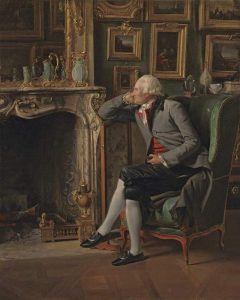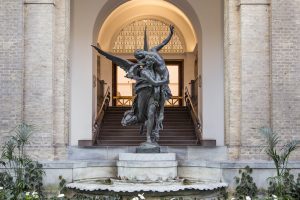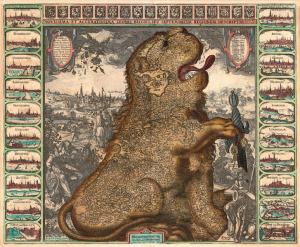Posté par Bérangère Poulain, le 2 novembre 2020;
- Date limite des propositions : 31 mars 2021
 Appel à communication : « Le Corps helvétique et la France (1660-1792). Transferts, asymétries et interdépendances entre des partenaires inégaux » (Colloque de la Société Suisse pour l’Étude du XVIIIe Siècle (SSEDS), 28-30 avril 2022) Appel à communication : « Le Corps helvétique et la France (1660-1792). Transferts, asymétries et interdépendances entre des partenaires inégaux » (Colloque de la Société Suisse pour l’Étude du XVIIIe Siècle (SSEDS), 28-30 avril 2022)
Château de Waldegg, Feldbrunnen-St. Niklaus (canton de Soleure)
28-30 avril 2022
Comité d’organisation : Simona Boscani-Leoni, Claire Gantet, André Holenstein, Timothée Léchot, Bérangère Poulain
Si le Corps helvétique et le royaume de France n’acquirent que dans la seconde moitié du XVIIe siècle une longue frontière commune, les relations politiques, diplomatiques et économiques entre les deux pays inégaux étaient déjà très étroites depuis le début du XVIe siècle. La Paix perpétuelle (1516) et l’alliance . . . → En lire plus
Posté par Ludovic Jouvet, le 11 septembre 2020;
En ligne, 18h30-20h00
Intervenant : Nicholas Parkinson (Ny Carlsberg Glyptotek)

À l’entrée du musée copenhaguois Ny Carlsberg Glyptotek, une sculpture occupe le devant de la scène – Gloria Victis, ou « gloire aux vaincus », un monument aux morts de la guerre de 1870 de l’artiste français Antonin Mercié.
Cette sculpture fut commandée par le collectionneur danois Carl Jacobsen en 1902, qui la plaça au beau milieu du jardin d’hiver du musée pendant son vernissage en 1906 – le même lieu où, deux ans plus tard, Jacobsen accueillera le président français Armand Fallières pendant sa visite au Danemark. Dans le contexte de sa mise en place . . . → En lire plus
Posté par Michele Tomasi, le 16 septembre 2019;
- Date et lieu des journées d'études : Lausanne, Université, site de Dorigny, 14-15 novembre

Université de Lausanne – Site de Dorigny 14-15 novembre 2019
La France en Italie. Artistes et œuvres français en Italie à l’époque gothique
Les échanges culturels entre la France et l’Italie ont toujours été un objet d’études important pour la recherche sur l’art médiéval, notamment pour l’époque gothique. Qu’il s’agisse d’artistes ou d’artefacts, d’idées artistiques ou de choix techniques, les interactions mutuelles constantes ont été une source d’inspiration pour les deux parties. Des artistes français ont travaillé en Italie ; si les voyages de membres des élites séculière et ecclésiastique ont aussi contribué à la circulation continuelle d’idée et d’œuvres tout au long du Moyen Âge central et tardif, certaines périodes ont connu une intensification des communications. Au XIVe siècle, les Angevins, en conquérant le royaume de Sicile, ont introduit . . . → En lire plus
Posté par Pascale Dubus, le 16 mars 2016;
- Date limite : 8 avril 2016
- Date et lieu du colloque : 15–18 février 2017, New York, CAA
 The field of cross-cultural studies represents a fertile area of investigation for early modern art historians. Recent scholarship has examined artistic exchange across cultures through trade, diplomacy and theft, the movement of artists across borders and oceans, and the cross-cultural appropriation of images and objects. Yet, the roles of women in these exchanges remain under-examined. This session examines the contribution of women as agents and promoters of inter-cultural exchange and explores the place of early modern women in the growing field of cross-cultural studies. The field of cross-cultural studies represents a fertile area of investigation for early modern art historians. Recent scholarship has examined artistic exchange across cultures through trade, diplomacy and theft, the movement of artists across borders and oceans, and the cross-cultural appropriation of images and objects. Yet, the roles of women in these exchanges remain under-examined. This session examines the contribution of women as agents and promoters of inter-cultural exchange and explores the place of early modern women in the growing field of cross-cultural studies.
Like their male counterparts, early modern women traveled throughout Europe and abroad. As they moved to other parts of the world, . . . → En lire plus
Posté par Pascale Dubus, le 6 octobre 2014;
- Date limite : 12 janvier 2015
- Date et lieu du colloque : 26–31 juillet 2015, Rotterdam, Erasmus University
 « Pictures in Motion: Portraiture around the World during the Long Eighteenth Century », session du 14e congrès de l’ISECS (International Congress for Eighteenth-Century Studies) consacré à l‘ouverture des marchés et du commerce au dix-huitième siècle au XVIIIe siècle, Rotterdam, Erasmus University, 26–31 juillet 2015. Pour plus d’informations, voir ici. « Pictures in Motion: Portraiture around the World during the Long Eighteenth Century », session du 14e congrès de l’ISECS (International Congress for Eighteenth-Century Studies) consacré à l‘ouverture des marchés et du commerce au dix-huitième siècle au XVIIIe siècle, Rotterdam, Erasmus University, 26–31 juillet 2015. Pour plus d’informations, voir ici.
Portraits and portraitists moved between courts, capitals, nations, and colonies in an ebb and flow that followed the tides of imperialism, markets, and diplomacy. Indeed, while portraits were understood as emphasizing the unique individual who could be regarded as a ‘defined location’ at the heart of . . . → En lire plus
Posté par Pascale Dubus, le 2 mai 2013;
- Date limite : 15 juin 2013
 During the seventeenth century the market for visual arts flourished in the Dutch Republic, ranging from cheap prints to top-quality paintings. Meanwhile the Southern Netherlands experienced an « Indian summer », pouring out tapestries, paintings, sculptures, books and musical instruments. Both artistic centres have been studied extensively, but mostly as separate entities. For example, the movement of artists has never been systematically mapped, just as very little is known about the trade in art objects and the exchanges in artistic styles between both regions. The aim of this conference, therefore, is to identify and explore the artistic dialogue between the Southern Netherlands and the Dutch Republic. During the seventeenth century the market for visual arts flourished in the Dutch Republic, ranging from cheap prints to top-quality paintings. Meanwhile the Southern Netherlands experienced an « Indian summer », pouring out tapestries, paintings, sculptures, books and musical instruments. Both artistic centres have been studied extensively, but mostly as separate entities. For example, the movement of artists has never been systematically mapped, just as very little is known about the trade in art objects and the exchanges in artistic styles between both regions. The aim of this conference, therefore, is to identify and explore the artistic dialogue between the Southern Netherlands and the Dutch Republic.
The first step . . . → En lire plus
|
Équipe Rédacteur en chef : Olivier Bonfait.
Rédacteurs : Elliot Adam (Moyen Age) ; Nicolas Ballet (XX-XXIe siècles) ; Matthieu Fantoni (musées) ; Antonella Fenech Kroke (bourses) ; Vladimir Nestorov (Lettre mensuelle)
Administrateur web : Matthieu Lett.
ancien éditeur : Pascale Dubus
anciens rédacteurs : Gautier Anceau, Sébastien Bontemps, Damien Bril ; Sébastien Chauffour ; Ludovic Jouvet ; Aude Prigot
|
 Appel à communication : « Le Corps helvétique et la France (1660-1792). Transferts, asymétries et interdépendances entre des partenaires inégaux » (Colloque de la Société Suisse pour l’Étude du XVIIIe Siècle (SSEDS), 28-30 avril 2022)
Appel à communication : « Le Corps helvétique et la France (1660-1792). Transferts, asymétries et interdépendances entre des partenaires inégaux » (Colloque de la Société Suisse pour l’Étude du XVIIIe Siècle (SSEDS), 28-30 avril 2022) 




